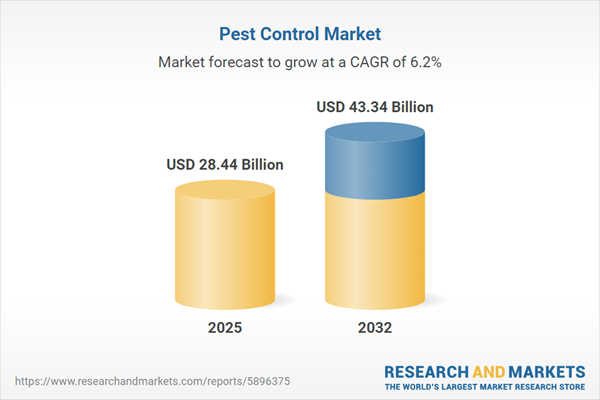Speak directly to the analyst to clarify any post sales queries you may have.
Senior executives in the pest control market operate at the intersection of regulation, technology, and sustainability, requiring strategic oversight to manage evolving risks and align service delivery with complex compliance and environmental demands.
Pest Control Market Snapshot: Size and Growth Trends
The global pest control market reached USD 26.76 billion in 2024, with projected growth to USD 28.44 billion in 2025 and continued expansion anticipated through 2032 in the U.S. A steady compound annual growth rate of 6.20% is supported by several drivers: urbanization accelerates the need for advanced pest management, climate factors bring new pest-related challenges, and an increasing emphasis on environmentally responsible practices shapes services and investments. To stay competitive, providers are evolving business models, adopting modern technologies, and promoting operational agility to keep pace with shifting risks and regulatory landscapes.
Pest Control Market Scope & Segmentation
A granular understanding of the pest control market’s structure empowers senior decision-makers to make informed investments, develop robust compliance strategies, and unlock differentiation opportunities across diverse operating environments. The following segments are central to formulating effective market strategies:
- Pest Types: Comprehensive solutions target ants, bed bugs, mosquitoes, cockroaches, flies, mice, rats, and termites, offering essential risk protection across food processing, property management, and industries with heightened sensitivity to health standards.
- Treatment Methods: Options include biological, chemical, and physical treatments to help balance regulations, minimize environmental impact, and meet high safety benchmarks in specialized sectors.
- Service Modes: Flexible offerings, including contract-based and standalone services, accommodate varying risk appetites, regulatory obligations, and budgetary constraints in both large and decentralized operations.
- End Use Applications: The market serves agriculture, healthcare, food and beverage, retail, hospitality, industrial, and residential settings, each demanding tailored approaches to address unique compliance mandates and performance expectations.
- Regional Coverage: The report evaluates practices across the Americas, Europe, Middle East and Africa, and Asia-Pacific, identifying how variations in legislation, pest ecology, and climate inform localization of pest management programs.
- Technological Features: Digital monitoring, sensor integration, and analytics enhance early risk detection, reporting efficiency, and responsiveness, strengthening overall incident management and supporting proactive service models.
- Key Companies Analyzed: Competitive benchmarking includes Rentokil Initial plc, Rollins Inc., ServiceMaster Global Holdings Inc., Anticimex AB, Ecolab Inc., Arrow Exterminators Inc., Massey Services Inc., Truly Nolen of America Inc., Cook’s Pest Control Inc., and Hawx Pest Control LLC to offer strategic insight into business model evolution and innovation.
Pest Control Market: Key Takeaways for Senior Decision-Makers
- Cloud-based digital monitoring and advanced detection technologies facilitate swift mitigation of pest threats, safeguarding ongoing operations and supporting business continuity protocols.
- Sustainability-focused models help organizations meet rising client and supplier expectations by integrating environmental priorities into procurement and operational practices.
- Application of analytics supports customized risk management approaches across asset portfolios, enhancing confidence among stakeholders and enabling proactive adjustments.
- Flexible procurement solutions and adaptable supply chain arrangements bolster the ability to navigate compliance changes across varied regional and national contexts.
- Investment in compliance and tracking technologies reduces administrative burdens and improves oversight for organizations managing multiple or geographically dispersed sites.
Tariff Impact on the Pest Control Industry
Recent adjustments to U.S. tariffs have influenced the cost structure for essential pest control equipment and supplies. In response, many companies are refocusing on strengthening supplier partnerships and adapting their service models. These strategies help reduce operational volatility and manage exposure to future pricing shifts.
Methodology & Data Sources
This analysis is informed by direct interviews with senior executives, agronomy specialists, and regulatory bodies. Findings are further supported through extensive literature review and robust scenario-based analysis to ensure accuracy and actionable insight.
Why This Report Matters
- Equips senior leaders to anticipate regulatory changes and strategically implement operational technologies for greater market resilience.
- Strengthens supply chain responsiveness and advances proactive risk management capabilities in dynamic environments.
- Provides focused insights to guide sustainability initiatives and compliance pathways that reflect sector trends and evolving client expectations.
Conclusion
This report offers senior decision-makers the clarity and actionable direction needed to optimize pest control operations and foster organizational resilience amid regulatory and environmental change.
Additional Product Information:
- Purchase of this report includes 1 year online access with quarterly updates.
- This report can be updated on request. Please contact our Customer Experience team using the Ask a Question widget on our website.
Table of Contents
3. Executive Summary
4. Market Overview
7. Cumulative Impact of Artificial Intelligence 2025
Companies Mentioned
The companies profiled in this Pest Control market report include:- Rentokil Initial plc
- Rollins, Inc.
- ServiceMaster Global Holdings, Inc.
- Anticimex AB
- Ecolab Inc.
- Arrow Exterminators, Inc.
- Massey Services, Inc.
- Truly Nolen of America, Inc.
- Cook’s Pest Control, Inc.
- Hawx Pest Control, LLC
Table Information
| Report Attribute | Details |
|---|---|
| No. of Pages | 193 |
| Published | October 2025 |
| Forecast Period | 2025 - 2032 |
| Estimated Market Value ( USD | $ 28.44 Billion |
| Forecasted Market Value ( USD | $ 43.34 Billion |
| Compound Annual Growth Rate | 6.2% |
| Regions Covered | Global |
| No. of Companies Mentioned | 11 |









